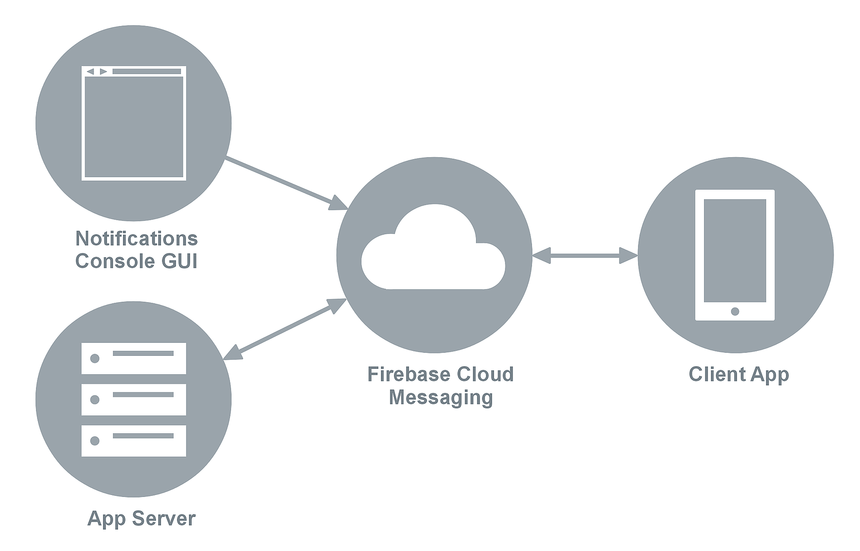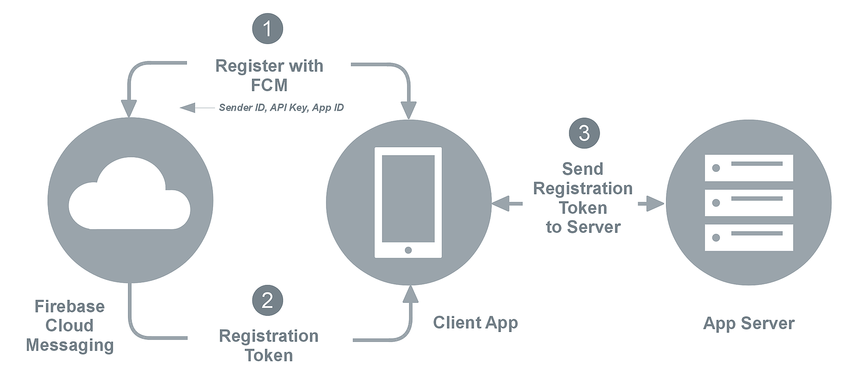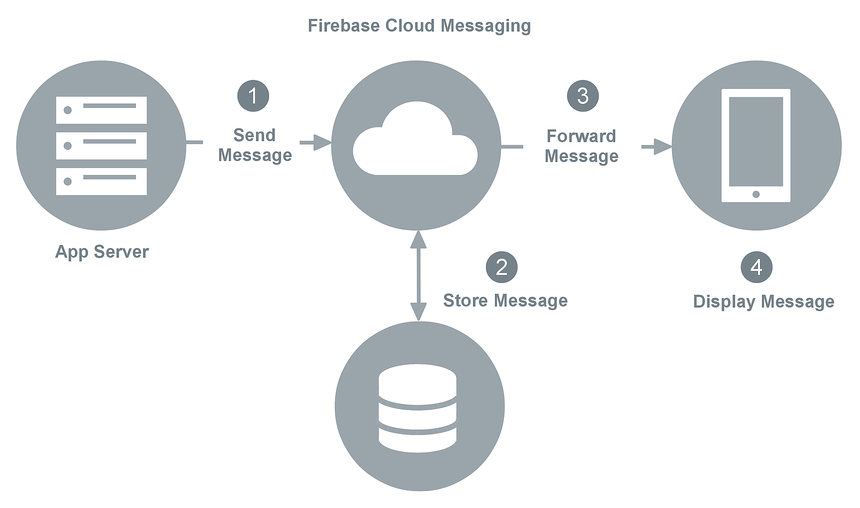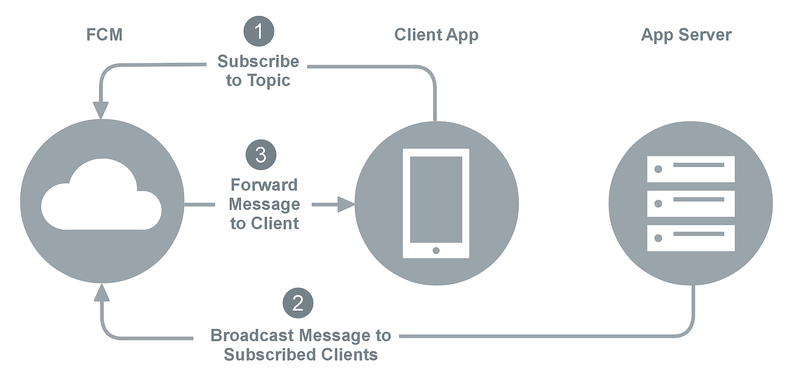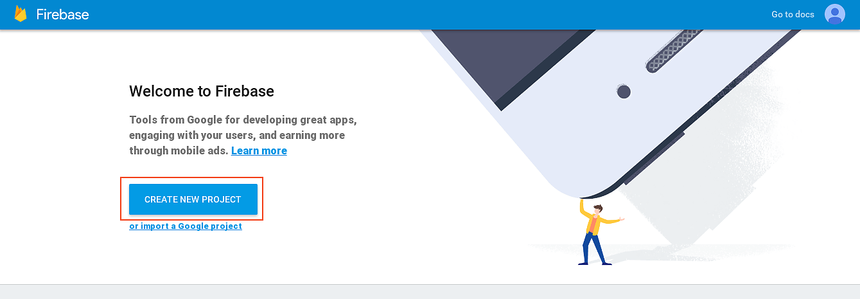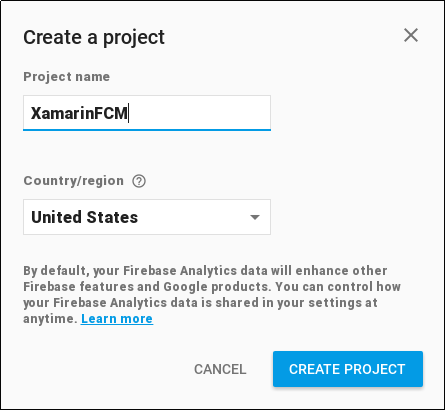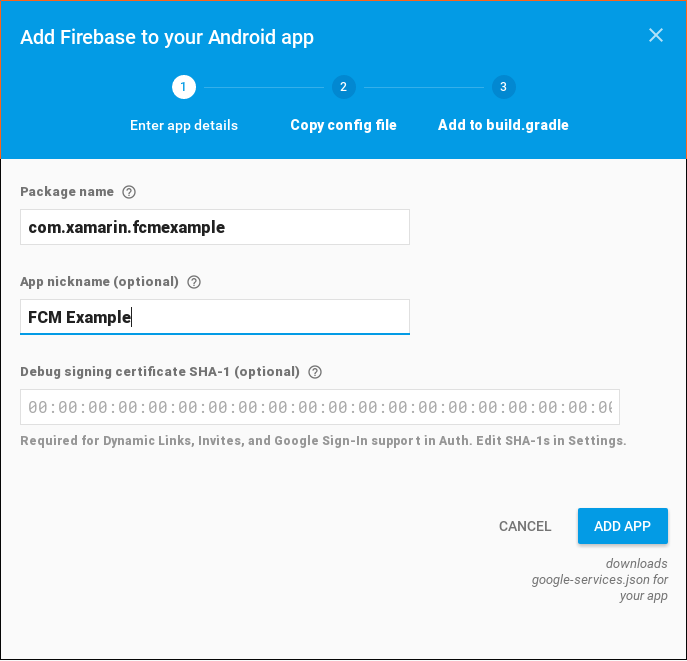Firebase Cloud Messaging
Firebase Cloud Messaging (FCM) is a service that facilitates messaging between mobile apps and server applications. This article provides an overview of how FCM works, and it explains how to configure Google Services so that your app can use FCM.
This topic provides a high-level overview of how Firebase Cloud Messaging routes messages between your Xamarin.Android app and an app server, and it provides a step-by-step procedure for acquiring credentials so that your app can use FCM services.
Overview
Firebase Cloud Messaging (FCM) is a cross-platform service that handles the sending, routing, and queueing of messages between server applications and mobile client apps. FCM is the successor to Google Cloud Messaging (GCM), and it is built on Google Play Services.
As illustrated in the following diagram, FCM acts as an intermediary between message senders and clients. A client app is an FCM-enabled app that runs on a device. The app server (provided by you or your company) is the FCM-enabled server that your client app communicates with through FCM. Unlike GCM, FCM makes it possible for you to send messages to client apps directly via the Firebase Console Notifications GUI:
Using FCM, app servers can send messages to a single device, to a group of devices, or to a number of devices that are subscribed to a topic. A client app can use FCM to subscribe to downstream messages from an app server (for example, to receive remote notifications). For more information about the different types of Firebase messages, see About FCM Messages.
Firebase Cloud Messaging in action
When a downstream message is sent to a client app from an app server, the app server sends the message to an FCM connection server provided by Google; the FCM connection server, in turn, forwards the message to a device that is running the client app. Messages can be sent over HTTP or XMPP (Extensible Messaging and Presence Protocol). Because client apps are not always connected or running, the FCM connection server enqueues and stores messages, sending them to client apps as they reconnect and become available. Similarly, FCM will enqueue upstream messages from the client app to the app server if the app server is unavailable. For more about FCM connection servers, see About Firebase Cloud Messaging Server.
FCM uses the following credentials to identify the app server and the client app, and it uses these credentials to authorize message transactions through FCM:
Sender ID – The Sender ID is a unique numerical value that is assigned when you create your Firebase project. The sender ID is used to identify each app server that can send messages to the client app. The sender ID is also your project number; you obtain the sender ID from the Firebase Console when you register your project. An example of a Sender ID is
496915549731.API Key – The API key gives the app server access to Firebase services; FCM uses this key to authenticate the app server. This credential is also referred to as the Server Key or the Web API Key. An example of an API Key is
AJzbSyCTcpfRT1YRqbz-jIwp1h06YdauvewGDzk.App ID – The identity of your client app (independent of any given device) that registers to receive messages from FCM. An example of an App ID is
1:415712510732:android:0e1eb7a661af2460.Registration Token – The Registration Token (also referred to as the Instance ID) is the FCM identity of your client app on a given device. The registration token is generated at run time – your app receives a registration token when it first registers with FCM while running on a device. The registration token authorizes an instance of your client app (running on that particular device) to receive messages from FCM. An example of a registration token is
fkBQTHxKKhs:AP91bHuEedxM4xFAUn0z ... JKZS(a very long string).
Setting Up Firebase Cloud Messaging (later in this guide) provides detailed instructions for creating a project and generating these credentials. When you create a new project in the Firebase Console, a credentials file called google-services.json is created – add this file to your Xamarin.Android project as explained in Remote Notifications with FCM.
The following sections explain how these credentials are used when client apps communicate with app servers through FCM.
Registration with FCM
A client app must first register with FCM before messaging can take place. The client app must complete the registration steps shown in the following diagram:
The client app contacts FCM to obtain a registration token, passing the sender ID, API Key, and App ID to FCM.
FCM returns a registration token to the client app.
The client app (optionally) forwards the registration token to the app server.
The app server caches the registration token for subsequent communications with the client app. The app server can send an acknowledgement back to the client app to indicate that the registration token was received. After this handshake takes place, the client app can receive messages from (or send messages to) the app server. The client app may receive a new registration token if the old token is compromised (see Remote Notifications with FCM for an example of how an app receives registration token updates).
When the client app no longer wants to receive messages from the app server, it can send a request to the app server to delete the registration token. If the client app is uninstalled from a device, FCM detects this and automatically notifies the app server to delete the registration token.
Downstream messaging
The following diagram illustrates how Firebase Cloud Messaging stores and forwards downstream messages:
When the app server sends a downstream message to the client app, it uses the following steps as enumerated in the above diagram:
The app server sends the message to FCM.
If the client device is not available, the FCM server stores the message in a queue for later transmission. Messages are retained in FCM storage for a maximum of 4 weeks (for more information, see Setting the lifespan of a message).
When the client device is available, FCM forwards the message to the client app on that device.
The client app receives the message from FCM, processes it, and displays it to the user. For example, if the message is a remote notification, it is presented to the user in the notification area.
In this messaging scenario (where the app server sends a message to a single client app), messages can be up to 4kB in length.
For detailed information about receiving downstream FCM messages on Android, see Remote Notifications with FCM.
Topic messaging
Topic Messaging makes it possible for an app server to send a message to multiple devices that have opted in to a particular topic. You can also compose and send topic messages via the Firebase Console Notifications GUI. FCM handles the routing and delivery of topic messages to subscribed clients. This feature can be used for messages such as weather alerts, stock quotes, and headline news.
The following steps are used in topic messaging (after the client app obtains a registration token as explained earlier):
The client app subscribes to a topic by sending a subscribe message to FCM.
The app server sends topic messages to FCM for distribution.
FCM forwards topic messages to clients that have subscribed to that topic.
For more information about Firebase topic messaging, see Google's Topic Messaging on Android.
Setting up Firebase Cloud Messaging
Before you can use FCM services in your app, you must create a new project (or import an existing project) via the Firebase Console. Use the following steps to create a Firebase Cloud Messaging project for your app:
Sign into the Firebase Console with your Google account (i.e., your Gmail address) and click CREATE NEW PROJECT:
If you have an existing project, click import a Google project.
In the Create a project dialog, enter the name of your project and click CREATE PROJECT. In the following example, a new project called XamarinFCM is created:
In the Firebase Console Overview, click Add Firebase to your Android app:
In the next screen, enter the package name of your app. In this example, the package name is com.xamarin.fcmexample. This value must match the package name of your Android app. An app nickname can also be entered in the App nickname field:
If your app uses Dynamic links, Invites, or Google Auth, you must also enter your debug signing certificate. For more information about locating your signing certificate, see Finding your Keystore's MD5 or SHA1 Signature. In this example, the signing certificate is left blank.
Click ADD APP:
A Server API key and a Client ID are automatically generated for the app. This information is packaged in a google-services.json file that is automatically downloaded when you click ADD APP. Be sure to save this file in a safe place.
For a detailed example of how to add google-services.json to an app project to receive FCM push notification messages on Android, see Remote Notifications with FCM.
For further reading
Google's Firebase Cloud Messaging provides an overview of Firebase Cloud Messaging's key capabilities, an explanation of how it works, and setup instructions.
Google's Build App Server Send Requests explains how to send messages with your app server.
RFC 6120 and RFC 6121 explain and define the Extensible Messaging and Presence Protocol (XMPP).
About FCM Messages describes the different types of messages that can be sent with Firebase Cloud Messaging.
Summary
This article provided an overview of Firebase Cloud Messaging (FCM). It explained the various credentials that are used to identify and authorize messaging between app servers and client apps. It illustrated the registration and downstream messaging scenarios, and it detailed the steps for registering your app with FCM to use FCM services.

